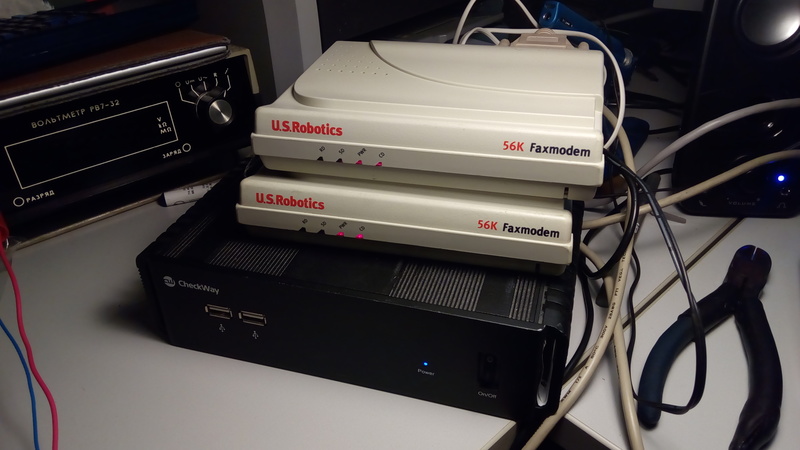
My network youth began with dial-up. BBS, internet via modem - in those days, other means of communication simply did not exist, and this was real magic. Dialing, then the cherished sounds caressing the ear, and now you are finally online, among the midnight geeks just like you, those who dream of being in touch.
I wanted to refresh my memory at least a little those wonderful times and play with modems. And here's what came of it.
Dial-up magic, a little nostalgia
Those who used dial-up don't know about slow internet.
A modem connection is probably one of the oldest long distance connections in computing. The telephone network in those years was very developed, and other networks simply did not exist in nature. And it would be foolish not to use it. Of course, the telephone network is not very suitable for data transmission, so for this purpose, modems were used that modulate the acoustic signal depending on the digital one and demodulate the acoustic signal into digital form. Hence the name of the modem - modulator-demodulator. Thus, a digital signal was cleverly converted into an audio signal and then back again, while filtering noise is also carried out. I will not dwell on the work of modems, especially since there were a lot of articles on this topic (for example)... But it is important to note that modern "modems" have nothing to do with the principle of operation of modems for telephone networks and are called "modem" completely undeservedly!
The magic of this method of communication lay in the fact that earlier, having a computer, you were cut off from the outside world. Yes, we carried programs on floppy disks, exchanged files and viruses. And then suddenly he appeared - dial-up. You plug in the telephone cable and ... And nothing happens, because you still have to know how to use this damn device.
First there was a terminal in Norton Commander and a trip to the BBS. Sleepless nights of dialing and now you finally got through, quickly download files, watch everything. But, unfortunately, my access to the network fell on the stage of Internet growth, so I didn't really see fidonet. That is, I only downloaded files, looked at pictures in ASCII.
Internet via modem, how much pain and joy of that time. How much money was spent on this Internet, horror ... I think in half a year I spend less money now than I spent then in a month. But we wanted to be online, we wanted to be in touch with each other. ICQs, chats, and the wonderful world opened at a glance. How many destinies, meetings, friends appeared then and with most of them I still communicate, which is amazing!
The magic of the dial-up connection is smartly played in the movie "The Matrix". At the beginning of the film, when Neo is parachuted from the Matrix into reality, a tricky acoustic connector is used.
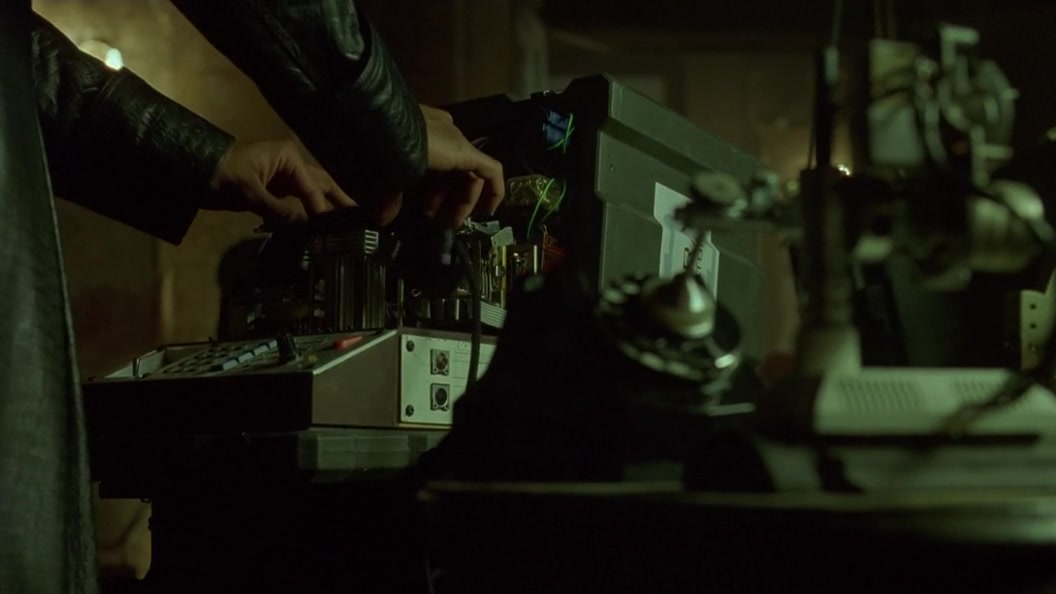
And in general, according to the film, the phone is used precisely for data transmission, communication and landing from the Matrix. This fits perfectly with the role that modems and telephone networks played in our life in the late 90s and early 2000s.
My modem youth
I will not list all the modems that went through my hands, there were a lot of them: internal, external, external battery-powered, built into a laptop, soft modems. But my favorite has always been US Robotics and external modems. My first modem was a 2400 bps noname ISA card, and the last was a 56k US Robotics Fax modem (popular cheap version). I have never had any handsome couriers, but sometimes now I have thoughts of buying it and putting it on the shelf, just for beauty, like people buy vases.
My favorite modem, which I have used for a very long time, and it suited me for everyone, was the US Robotics Sportster 28,800 Fax Modem . I liked him so much that I even took a photograph of him and can now look at him in a fit of nostalgia.
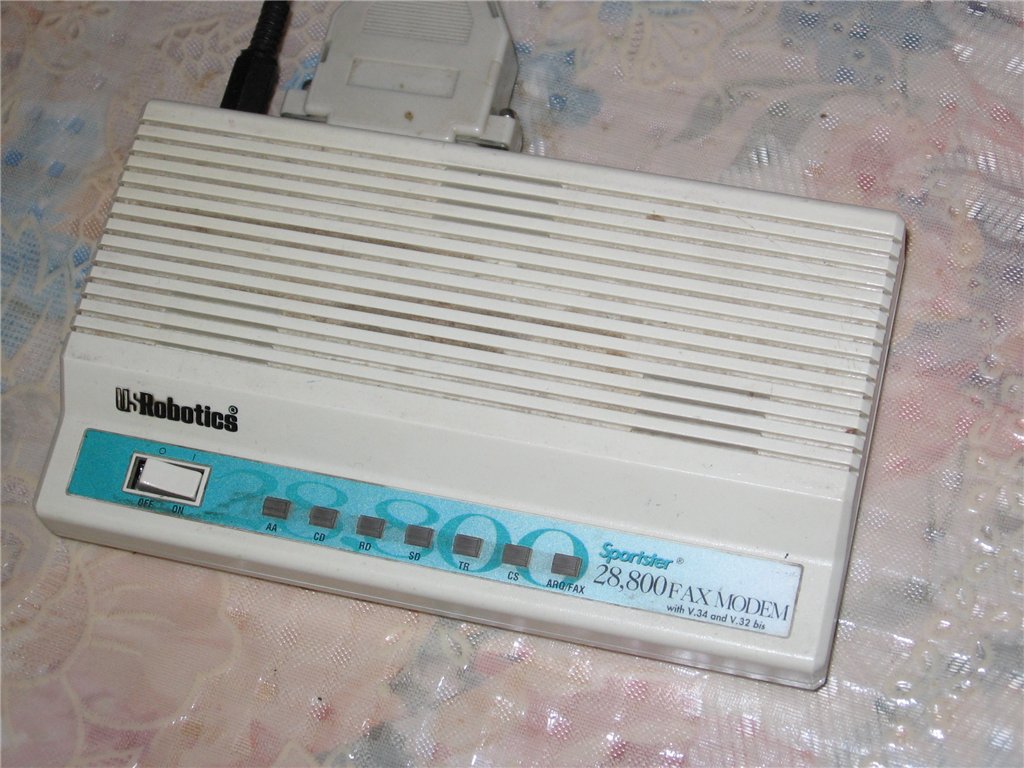
In general, I did not notice any tangible difference in modems at 33600, or even 56000 in comparison with 28800. I think that due to the peculiarity of my telephone line, it was impossible to reach speeds above 28800 on it. And, looking back, I understand that there was no particular point in changing modems.
But I wanted all kinds of phreaker's jokes. Whoever read my column in a popular magazine remembers that I was fascinated by all sorts of interesting phreaker devices for all sorts of games with the telephone network (eh, where are these times). And for such entertainment I bought myself a voice modem. It allowed in those days to bypass automatic caller IDs, change the voice of the caller and do a lot of cool things with our phone line. Its only drawback was its attachment to the socket. It was impossible to go with a laptop and connect to some protruding telephone line. So meet my favorite for different experiences US Robotics Sportster Voice Faxmodem 33.6 .

Oh, and how I just didn't have fun with him, pranks, pranks of friends, changing the caller ID number, and a lot of all sorts of cool things. But everything passes, including the fervor of fun. And so it was replaced with the dull white box of the US Robotics 56k Faxmodem .
I still remember that I configured all the modems for a long time using AT commands. I had a number with commas (pauses between numbers), this allowed me to dial up to the modem pool as efficiently as possible, in general it was a certain shamanism, so we wanted to get into tenacious paws the Internet.
I cannot fail to mention another interesting modem that I got at the time when I was connected to the Internet via twisted pair. This is a professional Motorola codex modem .Unfortunately, I have no photos of him left, so I am attaching a photo from the Internet.

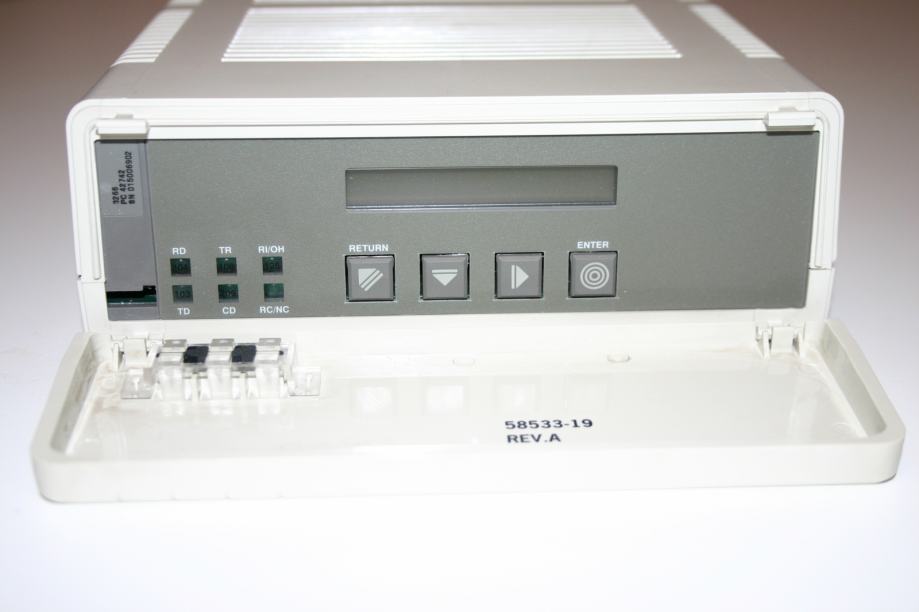
It is interesting in that it knows how to keep a connection apart from a regular telephone line, and also via twisted pair at a speed of up to 1 megabit (at the other end with the same modem). Which was very cool at the time. Another feature of this modem was a display and a keyboard, which allowed flexible configuration right from the front panel of the modem. There, in my opinion, even dialing could be done directly from him.
In general, a modem is a thing in itself, there is a DSP-processor, firmware, digital signal processing inside. And this magic strongly inspired me then to study the whole matter. And I even dreamed of making modems, but the dream was not destined to come true, since the age of computer networks came, which completely replaced telephone noodles and put an end to the modem future.
What about today?
And today dial-up has died. Even technically in Moscow, I have no idea how to connect via dial-up, because there are no telephone lines in their usual sense. Today, GPON technology has replaced all copper noodles and simply digitizes sound. As for me, this is not a lamp: dialing a modem through digital lines. Now it's even funny that on the network you can find logins and passwords with a non-zero balance in your personal account for dial-up connections. It used to be so valuable that the internet was stolen. Imagine stealing the Internet, it even sounds ridiculous, but it happened. Some one and a half years ago (at the end of 2018), I found such a personal account.
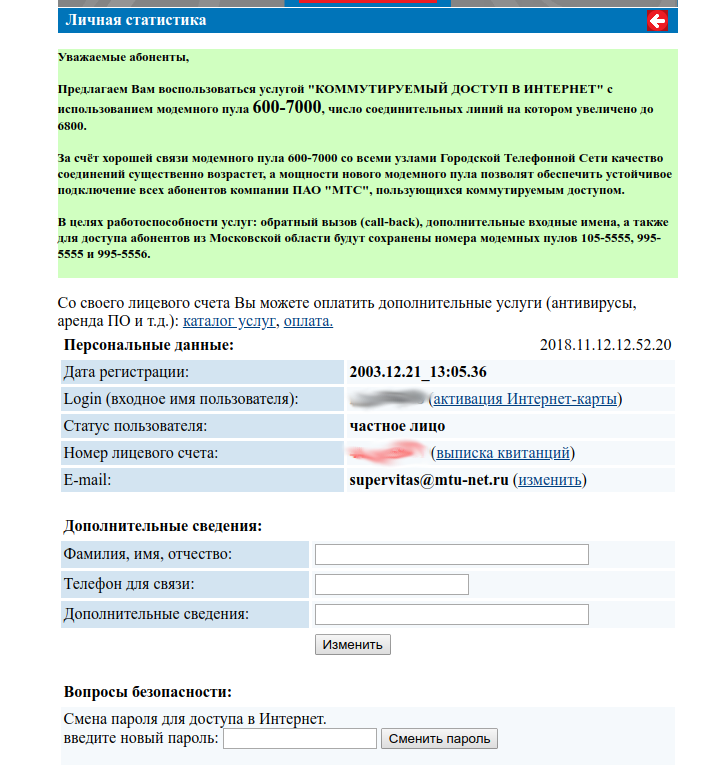
And he even called 8 (495) 600-7000, the modem answered, and there was some kind of life in his personal account at dialup.mtu.ru/cgi-bin/AA .
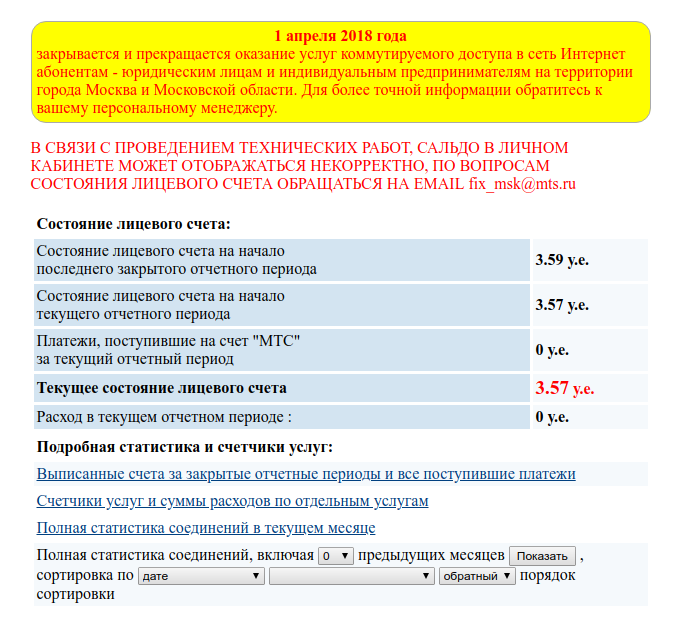
But today this number is not registered on the network and everything has died completely and irrevocably. And probably even all the modem pools were scrapped, not a museum. Eh ... A tear of nostalgia rolled down.
I can't even imagine if there is a live BBS today? And if so, how to connect to it? I also tried at least to make a call through a CSD connection (modem connection via GSM networks), but it turns out that the current operators do not support it. By the way, can someone tell me if it is possible for someone to connect it, or is it all dead too?
But let's digress from sad thoughts and still move on to experiments!
Connecting two modems
Finishing the lyrics, moving on to real deeds. At the moment, you can buy modems just for a song and do something cool and funny with them.
For these purposes, I bought two identical US Robotics 56k Faxmodem at once . As I understand it, these are office modems and they were sold immediately in a pack for 400 rubles. It's a pleasure for me to have fun with this now, because in those days modems were busy connecting to the Internet and it was a pity for free time for such games.
For experiments, I assembled a test bench, consisting of two computers: an industrial PC and my home computer, on which I am typing this post. One could do with one computer, but it seems to me - it will be a little unsportsmanlike. Still, I would like to make a classic modem connection of two computers. All machines have linux, and I communicate with the industrial PC via SSH. Yes, working with a modem via remote access over the network. It even sounds silly.

Test stand.
I use the excellent minicom as a terminal program. We supply power to the modem, launch minicom and configure it to work with the COM port to which the modem is connected. And let's get down to the fun!
One of the biggest problems for modem games today is the banal lack of a telephone line. Previously, she was everywhere, but recently I rarely see her in various apartments and offices in any form. Therefore, we will make the telephone line ourselves! To begin with, let's check the modem connection simply by noodles. With old school people who found dial-up, I had a dispute - can two modems be connected to each other simply by telephone noodles, without some kind of power source. And at the same time carry out the connection between each other. And it turned out that they can! And it's better to see once than read a hundred times.
And yes, there is a connection! Unstable, but it took place, the modems saw each other!
But you still can't use it. And if you still want to connect two modems, through noodles, then what to do? I found the answer on the website www.jagshouse.com/modem.html
The connection diagram is as follows.

That is, we need a 9-24 volt battery, a capacitor and a resistor. Instead of a battery, I used a 12 V battery. With this power supply, the resistor must be set to 500 ohms.

Assembled stand with active power supply.
I was not even too lazy to make a scarf for this business, so that everything was reliable and adult.
Connection succeeded! Without additional modem settings, on a basic configuration at a speed of 33600 bps! Imagine, on a straight line, without interference, the speed is 33600. If you play around with the modem's settings, you may be able to squeeze out even more. But I was already lazy to do this. It was important to check the very fact of the possibility of such a connection. I even tried transferring a file with this type of connection. I apologize for the quality of the photo, but what it is.
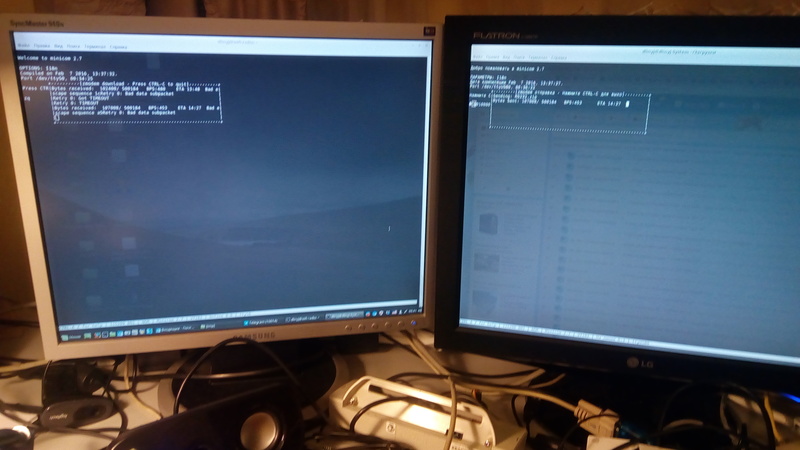
And, yes, the file has been transferred.
Acoustic connector
One of the most amazing modems is the speaker connector. When the phone is placed on the modem and the connection is made by sound. Yes, very low speed, and generally very unreliable, since external sounds also interfere. But it looks very cool. And I hope that someday I will see it live or even become the proud owner of such a device.

Acoustic connector (photo from open spaces).
Why am I telling all this? Everything is simple, today you do not need a modem in order to make a sound connection over the telephone network. A sound card is enough. Previously, the power of computers was not enough for these purposes. And when it became enough, soft modems appeared ... A kind of scarves, the work with the connection was taken over not by the DSP-processor of the modem, but by the driver of the operating system. And they cost much less than normal modems.
So, I digress, there is a minimodem project - a soft modem from a sound card. Project site http://www.whence.com/minimodem/ I
strongly recommend watching a video demonstration of work on the off-site.
To work with it, we install the software.
sudo apt-get install minimodemAnd now let's put together the speaker connector. We have a diagram above where we emulated a telephone line. If instead of one of the modems we connect a regular telephone, we will receive an acoustic modem and will use it for this connection. And the second side will be speakers that are simply connected to the sound card of the computer. And as a result, we get such an interesting experiment.
Better to see once than read a thousand times! Take care of your ears, blood will flow from your ears, for you will hear a real modem connection. I warned!
So you don't even have to buy a modem to start playing with modems. With the help of this program, it is even possible to connect to the BBS (if you can find a live one somewhere else).
Of the interesting things that I would like to have fun with is digging through the firmware of modems. Some of them were made on x86 architecture, and it would be fun to look under the hood. You can, of course, buy programmers, drain firmware, get bogged down in assembler codes, but I think there were probably enthusiasts who had fun like that. It is a pity that there was no Internet in those days, and therefore there is practically no information on the Internet.
Conclusion
The modem age has come to an end, even ADSL modem pools have closed. Telephone noodles are being digitized everywhere and disappear. This is the law of progress, it is neither bad nor good, it just is. But nevertheless, for me personally, it is a little sad that such wonderful mystical boxes disappeared from my desktop and do not please me with those amazing sounds that mark the connection to the network and meetings with like-minded people.

